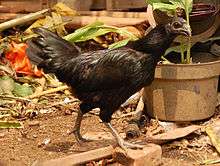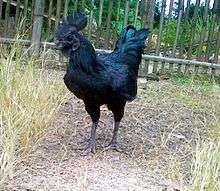Ayam Cemani
Ayam Cemani is an uncommon and relatively modern breed of chicken from Indonesia. They have a dominant gene that causes hyperpigmentation (fibromelanosis), making the chicken mostly black, including feathers, beak, and internal organs.
 Cemani hen | |
| Country of origin | Indonesia |
|---|---|
| Traits | |
| Weight |
|
| Skin color | Black with a Turquoise glow on the rooster neck side and tail. |
| Egg color | Tinted / Cream / Light Blue |
| Comb type | Single |
| Classification | |
| |

Etymology
Ayam means "chicken" in Indonesian, while cemani (originally a Javanese word) means 'thoroughly black (down to the bones).[1]
Origin
As a pure Indonesian breed, the breed originated from the island of Java, Indonesia, and have probably been used since the 12th century for religious and mystical purposes.[2]
The breed was first described by Dutch colonial settlers,[3] and first imported to Europe in 1998 by Dutch breeder Jan Steverink. Currently, this breed of chicken is kept in the Netherlands, Belgium, Germany, Slovakia, and the Czech Republic. Ayam Cemani may have also been brought to Europe by Dutch seamen.
The Congolese-Belgian philanthropist Jean Kiala keeps the largest collection in Africa with 250 breeding pairs. These are preserved in a breeding program by the African Ornamental Breeders Association (AOBA) in Kenya and the Democratic Republic of the Congo.[4]
Description
Their beaks and tongues, black combs and wattles, and even their meat, bones, and organs appear black. The blood of the Ayam Cemani is normally colored.[5] [2] The birds' black color occurs as a result of excess pigmentation of the tissues, caused by a genetic condition known as fibromelanosis.[6] This gene is also found in some other black fowl breeds.[7][8] The roosters weigh 2.0–2.5 kg and the hens 1.5–2.0 kg. The hens lay cream-colored eggs, although they are poor setters and rarely hatch their own brood. Eggs weigh an average of 45 g.
See also
References
- "Arti kata cemani - Kamus Besar Bahasa Indonesia (KBBI) Online". kbbi.web.id. Retrieved 2020-07-08.
- Solly, Meilan (September 19, 2019), These Chickens Have Jet Black Hearts, Beaks and Bones, retrieved May 18, 2020
- Lukanov, H.; Genchev, A. (September 2013). "Fibromelanosis in domestic chickens" (PDF). Agricultural Sciences and Technology. 5 (3): 239–246.
- https://ornamental-breeders.org/
- "'Public Radio International's 'The World'". October 14, 2016.
- Shinomiya, Ai; Kayashima, Yasunari; Kinoshita, Keiji; Mizutani, Makoto; Namikawa, Takao; Matsuda, Yoichi; Akiyama, Toyoko (February 2012). "Gene Duplication of endothelin 3 Is Closely Correlated with the Hyperpigmentation of the Internal Organs (Fibromelanosis) in Silky Chickens". Genetics. 190 (2): 627–638. doi:10.1534/genetics.111.136705. PMC 3276631. PMID 22135351.
- Dorshorst, Ben; Molin, Anna-Maja; Rubin, Carl-Johan; Johansson, Anna M.; Strömstedt, Lina; Pham, Manh-Hung; Chen, Chih-Feng; Hallböök, Finn; Ashwell, Chris; Andersson, Leif (December 2011). "A Complex Genomic Rearrangement Involving the Endothelin 3 Locus Causes Dermal Hyperpigmentation in the Chicken". PLOS Genetics. 7 (12): e1002412. doi:10.1371/journal.pgen.1002412. PMC 3245302. PMID 22216010.
- Arora, G.; Mishra, S. K.; Nautiyal, B.; Pratap, S. O.; Gupta, A.; Beura, C. K.; Singh, D. P. (2011). "Genetics of hyperpigmentation associated with the Fibromelanosis gene (Fm) and analysis of growth and meat quality traits in crosses of native Indian Kadaknath chickens and non-indigenous breeds". British Poultry Science. 52 (6): 675–685. doi:10.1080/00071668.2011.635637.